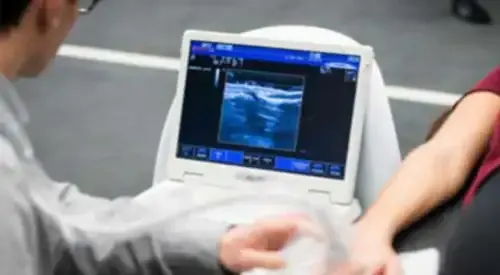Hidrosadenitis suppurativa
"More severe cases should be treated at a center with dermatologists experienced in the surgical treatment of this disease."
DR. MARÍA HUERTA
SPECIALIST. DERMATOLOGY DEPARTMENT

What is hidrosadenitis suppurativa?
Hydrosadenitis or hydradenitis is a chronic, autoinflammatory skin disease, with outbreaks of varying intensity, characterized by the presence of boils, painful nodules and/or abscesses predominantly affecting the large body folds, especially the axillae, groin and anogenital region.
It may progress to a chronic inflammatory state with formation of fistulous tracts, malodorous discharge, dermal fibrosis and hypertrophic scarring.

What are the symptoms of hydrosadenitis?
Hydrosadenitis manifests itself between the second and third decade of life (after puberty) and significantly impairs the quality of life of affected patients, both physically, emotionally and professionally.
Depending on the course of the disease, patients initially present painful nodules or abscesses in areas of friction, moisture and heat (axilla, groin, buttocks, breasts).
In more severe forms, it may progress to form fistulous tracts draining purulent contents, give off a foul odor and may lead to deforming scars.
Obesity and smoking may worsen the patient's prognosis.
What are the most common symptoms?
- Painful nodules with inflammatory signs.
- Foul-smelling discharge.
- Fibrosis and hypertrophic scars, when they evolve.
Do you have any of these symptoms?
You may have hydrosadenitis
Who can suffer from hydrosadenitis?
Some risk factors that favor the development of this disease are:
- Gender: Women are more likely to develop hidradenitis suppurativa than men.
- Alterations in the skin microbiota.
- Smoking.
- Overweight or obesity.
- Other chronic inflammatory diseases.
- Tight clothing (due to excessive friction with the skin).
- Some drugs containing lithium or tyrosine kinase inhibitors.
- Some contraceptives can cause outbreaks, although those with a specific profile (anti-androgenic) can also be used as treatment, according to medical indications.
- Genetic predisposition: generally more people in the family present this or other dermatological pathologies related to follicular occlusion.
How is hydrosadenitis diagnosed?

The diagnosis of hydrosadenitis is clinical and straightforward for a dermatology specialist. Occasionally, other physicians may interpret an outbreak as an infection.
Sequelae and scarring are diagnostic clues. In latent or episodic cases, the specialist can reach a diagnosis by observing the scars and know if a person is suffering or has suffered from hydrosadenitis even if there are no active lesions at the time.
Skin ultrasound: this is very important to determine the severity and extent of the disease.
How is herpes zoster treated?
- Pharmacological treatment: antibiotics, topical, intralesional or oral corticosteroids, topical and/or oral retinoids, metformin, antiandrogens and biological drugs, in addition to analgesia.
- Laser hair removal: in these patients, especially in women hair removal is key, since the problem originates in the hair follicle.
- Minor surgery: Drainage of abscesses and unroofing (removal) only of fistulous tracts with CO2 laser.
- Major surgery. Surgical treatment, in the most severe cases. Surgical removal of all the affected skin and reconstruction of the defects with grafts.
- Clinical trials with biologic drugs.
In more severe cases of hydrosadenitis it is necessary to perform a combined medical and surgical treatment.
The approach to this problem by a multidisciplinary team of professionals, composed of the following areas: Dermatology, Plastic Surgery, General Surgery (coloproctology), Endocrinology, Psychiatry and Psychology and Family Medicine (for the control of cardiovascular risk factors), increases the chances of solving the problem.
- Major surgery: Surgical treatment with removal of all the affected skin and reconstruction of the defects or local grafts or flaps. It is an important part of disease control when there is a fistulous tract or large abscesses. More severe cases require a good surgical approach by dermatologists who are experts in the surgical treatment of hydrosadenitis.
- Nursing care of the surgical wound.
- Laser treatment of scars.
Where do we treat it?
IN NAVARRE AND MADRID
The Department of Dermatology
of the Clínica Universidad de Navarra
The Department of Dermatology of the Clinica Universidad de Navarra has extensive experience in the diagnosis and treatment of dermatological diseases.
We have extensive experience in highly precise surgical treatments, such as Mohs surgery. This procedure requires highly specialized personnel.
We have the latest technology for the dermo-aesthetic treatment of skin lesions, with the aim of achieving the best results for our patients.
Diseases we treat

Why at the Clinica?
- Experts in Mohs Surgery for the treatment of skin cancer.
- We have the best technology for dermo-aesthetic treatments.
- Safety and quality assurance of the best private hospital in Spain.








